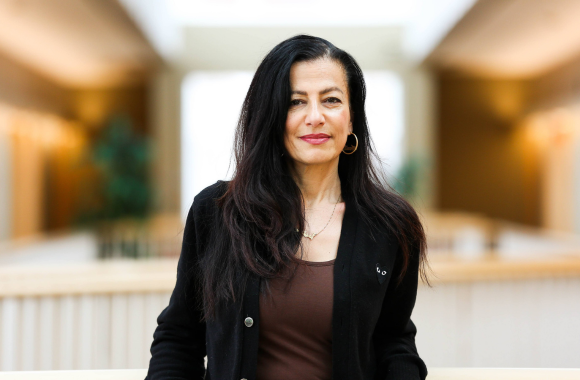
Amitis Motevalli, Visiting Fellow in Gender, Body Politics, and Iranian Art
Amitis Motevalli's work explores the cultural resistance and survival of people living in poverty, conflict and war.
An Interview With Artist Amitis Motevalli, Visiting Fellow in Gender, Body Politics, and Iranian Art
Amitis Motevalli is an artist who explores the cultural resistance and survival of people living in poverty, conflict and/or war. Her experiences as a trans-national migrant and community organizing are foundational in her work and research. Through many media, digital, analog, static and live, her work juxtaposes and contrasts iconography with iconoclasm, memorials with monuments, archive methodologies with canon. Her work intends to ask questions about archiving, documentation and canonization of histories, in particular related to violence. In this line of questioning she subverts populism by invoking the significance of a secular grassroots struggle. She is primarily based in Los Angeles, exhibiting art internationally as well as organizing to create an active and critical cultural discourse through information exchange—either in art or pedagogy—with cultural producers and educators.
Soon after Amitis Motevalli arrived at Brown, we asked her some questions about her life and work:
Your bio says that you work across many mediums. Will you be focusing on any particular mediums during your time at Brown?
While at Brown, I will be focusing on beginning the first pieces of a manuscript connected to my overall Golestān Revisited project. Using the name of Sa’adi Shirazi’s seminal book of poetry and prose, took me in the direction of making a manuscript, although mine will be experimental in nature and medium. I will also be in the library studying traditional Iranian manuscripts and illustrations of text, as well as botanical drawings such as Redouté’s roses.
Can you elaborate on the importance of the shrine in Iran, which your family has long maintained, to your artistic work, or to you as a person?
For a very long time, the shrine if Imamzadeh Yahya in Sari was a haunting memory. I tried to reconstruct what it looked like and what it felt like going there. Once I finally went back to Iran in 2005, I visited the shrine as well as others. What was amazing to me is that the shrine was a collective art piece made by the community. And the rites around visitation and care of this facility was also a performative act agreed upon by the community. I think it really took me in the direction of referencing community art in my work.
Who have been your most important artistic influences?
My influences are mostly experiences and observation, like going to masjids and shrines and seeing how emotive space can become. Also, when I was a child my mother’s friend, Roohee Mirbaha, was commissioned to travel around Iran and do botanical renderings of Iran’s indigenous flowers and plants. She taught me to draw a tulip, but watching her work on the renderings was more of the lesson. When I was a teen, I exposed myself to many different creative practices, reading, listening, looking. I think all of that was important. I used to help performance artist Vaginal Davis when they were doing The Afro Sisters and other projects. Vag was kind, fun, groundbreaking and brilliant in the most natural way. That was deeply inspiring.
What role do you think art plays for those who have survived poverty, conflict, and/or war?
I understand that people use art for therapy and I believe it is effective. I use art as my means to express expansive ideas. I’m diasporic, English is not my first language, and I’ve lost my deep connection with Farsi, so I was left with tapping into my other modalities.
Which of your works up to this point has been most meaningful to you? Why?
There’s a series I started in my first year of graduate school called The Stretch Manifesto. With this series, I took inspiration from women and femmes in sex work. I also was inspired by the fundamentals of Islamic art. The two inspirations come together in a fascinating way.
Do you sell your work? What does it feel like to sell a piece of your art?
I do sell some of my work. My work isn’t decorative, so it’s not for hanging above a couch. I once had a woman purchase one of my pieces out of a series to hang in her boutique in Santa Monica California. This may seem odd, but I was not happy about that. I wanted the series together and I kept saying I wanted to filter who can purchase my works, etc… I had to let go of that. I do have to say, I love it when a series sells together or is not taken out of context.
Is art a factor in your family life? Are there other artists in your family, or are you the first?
My matrilineage is highly creative, my patrilineage are not so much. I am the first in the family to be labeled by others as an artist.
Does the art market (either making sales or finding galleries in which to exhibit) place pressures on you as an artist?
I can’t say the art market doesn't occasionally place pressure on me. I would love to be in my studio making my work all day. In the end, the work I make doesn’t cooperate with the art market. The market influences gatekeepers in academia and museums as well. Ultimately, I don’t think I would be happy spending all of my time just making art if I had to cater to a market. What ends up taking over is my feeling of a calling, and dedication to truth, justice and connecting with everyday people.
Any other question you wish we had asked?
Sun Sign: Scorpio
Moon Sign: Leo
Rising: Leo
Diet: Vegetarian
Favorite flower: Rose
